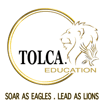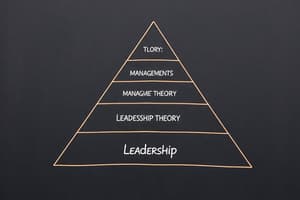Podcast
Questions and Answers
What is the primary leadership style that involves making decisions without consulting others?
What is the primary leadership style that involves making decisions without consulting others?
- Democratic Leadership
- Transformational Leadership
- Laissez-Faire Leadership
- Autocratic Leadership (correct)
Which of the following skills becomes less important as one moves up the organizational hierarchy?
Which of the following skills becomes less important as one moves up the organizational hierarchy?
- Interpersonal Skills
- Conceptual Skills
- Human Skills
- Technical Skills (correct)
According to Maslow's Hierarchy of Needs, which need must be satisfied before an individual can focus on esteem needs?
According to Maslow's Hierarchy of Needs, which need must be satisfied before an individual can focus on esteem needs?
- Safety
- Physiological
- Self-Actualization
- Love/Belonging (correct)
Which characteristic is considered essential for a good leader when it involves knowing one’s capabilities and acknowledging limitations?
Which characteristic is considered essential for a good leader when it involves knowing one’s capabilities and acknowledging limitations?
What is the primary goal of rewarding top talent in an organization?
What is the primary goal of rewarding top talent in an organization?
What type of workplace trend is characterized by moving away from traditional cubicles?
What type of workplace trend is characterized by moving away from traditional cubicles?
Which of the following is NOT a key human skill essential for effective management?
Which of the following is NOT a key human skill essential for effective management?
What is the fundamental purpose of leadership, according to Mary Parker Follett?
What is the fundamental purpose of leadership, according to Mary Parker Follett?
Which of the following is a characteristic of SMART goals?
Which of the following is a characteristic of SMART goals?
What is a contingency plan primarily concerned with?
What is a contingency plan primarily concerned with?
Which of the following best describes organizational charts?
Which of the following best describes organizational charts?
Which managerial skill is most crucial for senior management?
Which managerial skill is most crucial for senior management?
Which of the following qualities is considered less important for successful leaders?
Which of the following qualities is considered less important for successful leaders?
In terms of leadership qualities, what trait is essential for fostering collaboration?
In terms of leadership qualities, what trait is essential for fostering collaboration?
Which of the following is not a component of Maslow's Hierarchy of Needs?
Which of the following is not a component of Maslow's Hierarchy of Needs?
When assessing values in leadership, which question should not be included?
When assessing values in leadership, which question should not be included?
Which leadership style is best suited for generating creative ideas?
Which leadership style is best suited for generating creative ideas?
What is a primary characteristic of Laissez-faire Leadership?
What is a primary characteristic of Laissez-faire Leadership?
Which step is NOT part of the controlling process?
Which step is NOT part of the controlling process?
What dimensions does the Balanced Scorecard NOT measure?
What dimensions does the Balanced Scorecard NOT measure?
What is the purpose of establishing clear standards in the controlling process?
What is the purpose of establishing clear standards in the controlling process?
Which of the following is a key component of effective contingency planning?
Which of the following is a key component of effective contingency planning?
Which managerial skill is primarily associated with effectively communicating results?
Which managerial skill is primarily associated with effectively communicating results?
Which question is most relevant during the planning stage of management?
Which question is most relevant during the planning stage of management?
Flashcards are hidden until you start studying
Study Notes
Organizational Hierarchy
- Technical skills become less important and conceptual skills become more important as you move up the organizational hierarchy.
- Human skills remain consistently important at all levels.
Designing Processes and Procedures
- Processes: How information is shared, decisions are made, and people work together. This includes office spaces and information systems.
- Traditional cubicles are being replaced with open workspaces designed to be more comfortable, open, and encourage collaboration.
Rewarding Top Talent
- Rewards are incentives that encourage good behavior and retain valuable employees.
Leading
- Leading goes beyond authority; it involves influencing others to want to do something.
What Makes a Good Leader?
- Drive: Energy and ambition.
- Cognitive Ability: Ability to absorb and use large amounts of information.
- Self-Confidence: Understanding one's abilities, how to use them, and acknowledging what is unknown.
- Honesty and Integrity: Being trustworthy for building strong relationships.
- Leadership Motivation: Inspiring others.
Motivating People
- Maslow's Hierarchy of Needs: A framework identifying the specific order of needs that must be fulfilled, starting from the most basic:
- Physiological: Food, water, shelter.
- Safety: Security and stability.
- Love/Belonging: Desire to be accepted.
- Esteem: Desire to be respected by others.
- Self-Actualization: The desire to fulfill one's potential.
- Satisfying these needs is crucial for creating employees motivated to grow and contribute to a more productive workplace.
Leadership Styles
- Autocratic Leadership: Making decisions without consulting others.
- This style is useful for quick decisions and managing new employees who require guidance.
- However, it can hinder employee empowerment, initiative, and motivation in the long run.
- Democratic Leadership: Making decisions with others and working together towards a shared conclusion.
- Builds positive relationships and increases employee satisfaction.
- Effective for generating creative ideas and brainstorming.
- Can be time-consuming and not ideal for emergencies.
- Laissez-faire Leadership: Setting goals for employees to achieve using their own methods.
- Builds initiative and empowers employees.
- Requires a skilled and trusted workforce.
- Best used with trained professionals.
Control
- Purpose of Control: To gather feedback to ensure goals are being met, enabling actions to align with the vision and mission statements.
The Five Steps of Controlling
- Step 1: Establishing Clear Standards: Define specific numbers or metrics like customer satisfaction for benchmarking against actual results.
- Step 2: Monitoring and Recording Performance: Track and document progress.
- Step 3: Comparing Results to Standards: Analyze performance against established benchmarks.
- Step 4: Communicating Results: Share performance data with relevant stakeholders.
- Step 5: Taking Corrective Action: Implement necessary changes, like contingency plans, or reassess goals if needed.
The Balanced Scorecard
- Definition: A tool measuring a company's performance across four key areas:
- Financial : Key financial numbers, such as sales targets.
- Customer: Client satisfaction and metrics like customer retention.
- Business Processes: Operational performance, like speed of customer service and complaint resolution.
- Learning & Growth: Ability to support and develop employees, including employee retention and promotion.
Organizational Charts
- Organizational charts depict:
- The number of employees, their functions, and their positions and relationships.
- How information flows within departments and teams.
- Can be vertical or horizontal.
Management Skills
- Senior Management: Expected to have the most conceptual skills.
- First-Line Management: Expected to have the most technical skills.
Rewards
- Rewards: Incentives, compensations, and other benefits given to encourage desired behaviors within an organization.
Traits of Successful Leaders
- Important Traits:
- Motivation
- Adequate communication
- Honesty
- Leadership motivation
Maslow's Hierarchy of Needs (Continued)
- Criteria:
- Physiological
- Love and Belonging
- Self-Actualization
Important Note
- Vision: Represents the organization's current purpose and potential.
- Mission Statement: Describes the fundamental beliefs that guide decision-making within the company.
Goal Setting
- Goals should be:
- Timely: Have a defined timeframe.
- Difficult to achieve: Challenging but attainable.
Values and Leadership
- Senior leadership should ensure that values are followed by asking:
- Are values modeled by leaders within the organization and communicated to all employees?
- How do we get there from here?
Contingency Plans
- Contingency plan: A course of action taken when original plans do not go as anticipated.
Organizing Function of Management
- Organizing: Includes:
- Putting plans into action.
- Designing the structure of the organization.
True or False
- False: The vision of an organization is their current purpose and what they can do, and the mission statement describes the fundamental beliefs that guide decision making in a company.
Studying That Suits You
Use AI to generate personalized quizzes and flashcards to suit your learning preferences.





